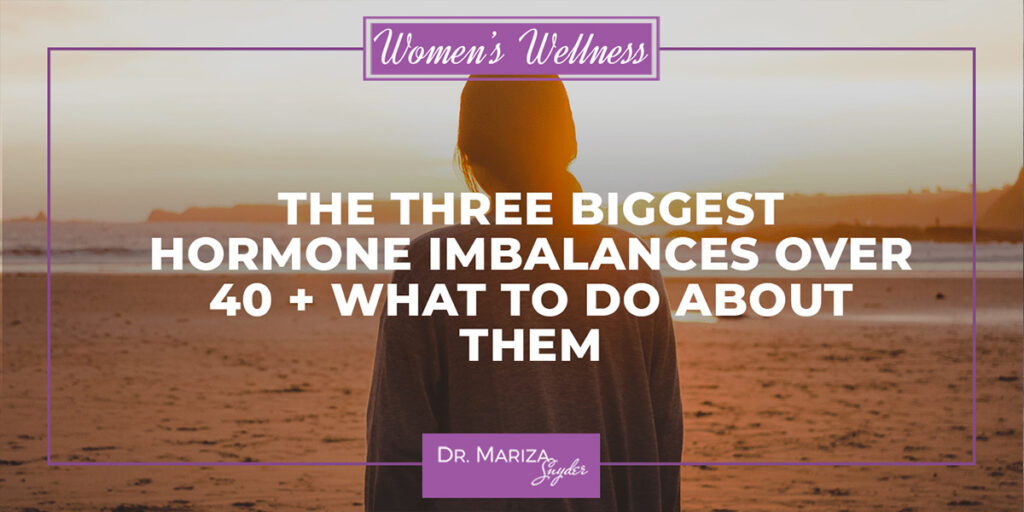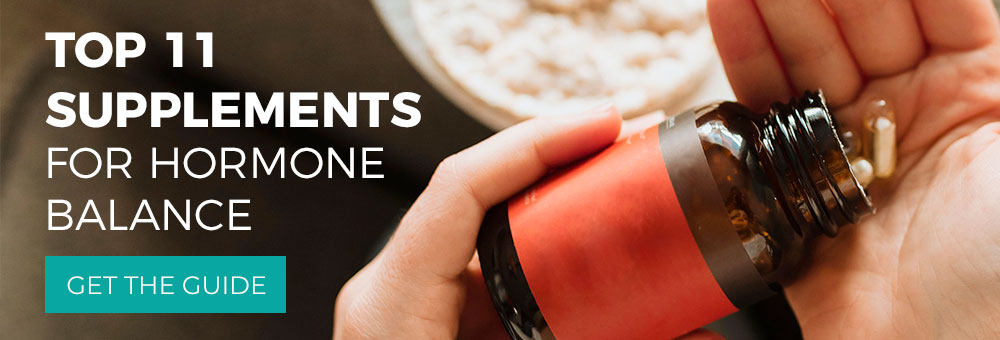
You hit 35 or 40, and suddenly, everything changes.
- You have ZERO energy and rely on sugar, double-strength coffee, or a nap to get you through your workday (and you still crash at 8 PM, totally spent)…
- Your jeans that fit so well a month ago suddenly can’t button without some serious sucking-in (and you’re tempted to just go out with them unbuttoned)…
- Your PMS hits you like a Mack truck every single month, even if you never struggled with it before…
- And maybe you even are facing more serious issues like fibrocystic breasts, uterine fibroids, and are afraid of what the next few years are going to hold.
Your hormone balance is so delicate, to begin with, and suddenly perimenopause sends it into an unpredictable flux where anything is game.
We all know about menopause… the hot flashes, night sweats, weight gain, and other unsavory things generations ahead of us have warned us about.
But perimenopause is a totally different beast.
Menopause is officially when you haven’t had a period for 1 full year. Perimenopause is the 10+ year period leading up to that point, and really, it’s the harder of the two.
Because you don’t know when it’s going to hit…
Because no one is talking about it…
Because you feel so alone in what you’re feeling.
But the reality is: you have WAY more control over your body and hormones than you might realize!
There’s a reason for all the ways you’re feeling right now. You are NOT the only one suffering. And there’s a way out from the weight you’re carrying.
Estrogen and progesterone are the most well-known hormones that get attention, especially as you approach menopause, but they may not actually be the biggest culprits.
Below, I am unpacking the biggest hormone imbalances that appear after 35 and how you can identify (even WITHOUT extensive, costly lab work) which ones you need to address!
Wherever you find yourself right now, know this: the power to create a vibrant, energized life is in YOUR hands. Your symptoms are signs from your body saying “something is NOT right, and NOW is the time to take action.”
Here are the 3 Biggest Hormone Imbalances in Women 35+ and What You Can Do NOW to Keep Them in Balance
#1 – Estrogen Dominance
Full disclosure: I have had estrogen dominance in my late 30s. How did I know? After three months of heavy periods, migraines, and breast tenderness accompanied by severe PMS symptoms, I knew that my estrogen levels were higher than progesterone, causing my symptoms.
Are you there too? Have you looked at yourself recently and wondered, “Where did I go? What happened to my energy, ability to sleep, predictable mood and period, etc.?”
If that describes where you are, you are not alone. Women over 35 are dealing with an epidemic of estrogen dominance, and it’s taking its toll on your productivity, your energy, your motivation, and your body.
This is something you do NOT want to ignore.
The heavy bleeding, painful periods, fibroids, fibrocystic breasts, migraines, etc. are your body’s way of sending a signal that something is not right. If you just “push through it” or try to counteract it with more hormones, it’s likely to lead to something WAY more serious down the line, like breast or uterine cancer.
That’s why it’s so important to pin this down NOW before it gets to that point, and while you can still address it naturally.
CLICK HERE TO TAKE A SIMPLE ASSESSMENT TO SEE IF YOU COULD HAVE ESTROGEN DOMINANCE >>
What to do about it?
Fixing your estrogen dominance isn’t going to happen overnight. There are so many factors involved that you need to take into account (like your gut, liver, and stress levels), but it is SO worth your time and effort to prevent future, more catastrophic health issues AND to get you feeling better ASAP!
In this post, I cover the root causes of what leads to estrogen dominance in the first place so you can tackle it from the source. Click to read now >>
Step #1 you can do today:
If you’re where I was, desperate for ANYTHING that would bring relief (short of major surgery and dangerous synthetic treatments), your best option is to invest in quality natural topical progesterone. Because the biggest issue with estrogen dominance is not necessarily high estrogen but lacking the progesterone to balance it out (click here to read more on that), upping your progesterone levels can be a simple and effective way to get relief fast!
Essentially Whole Progest-Restore is what I recommend because I know it’s created without any harmful synthetics or hormone-look-alikes that wreak havoc on your already delicate hormonal state. Take the edge off this transition and restore immediate relief to your body with Progest-Restore—an all-natural, bioidentical progesterone cream that is designed to work with your body instead of against it!
Progest-Restore contains only pure, bioidentical progesterone along with all-natural carriers that make it easier for your body to put to use so you can be totally confident in what you’re applying to your skin!
#2 – Insulin Resistance
Insulin resistance hides behind two of the most common symptoms women experience during perimenopause: fatigue and weight gain.
But beyond that, it’s a syndrome at the center of many chronic health problems, including diabetes, obesity, heart disease, and PCOS. Insulin is one of the “major” hormones and it has a huge cascading effect on the rest of your hormones, including estrogen and progesterone.
The biggest signs that point to insulin resistance include:
- Sudden, stubborn weight (especially in your midsection) that you struggle to lose even if you’re eating “right” and exercising
- Feeling addicted or reliant on sugar or carb-filled snacks to get you through your day
- Brain fog and trouble focusing
- Exhaustion
- Hot flashes
Insulin resistance occurs, for many of us, because most of our calories come in the form of simple carbohydrates (rice, bread, desserts, chips, certain fruits, and fruit juice). These are sugars that quickly enter the bloodstream as glucose.
Your body has to spike high levels of insulin to keep all that glucose in the bloodstream from spiraling out of control. Over time, our cells simply can’t keep up. They stop responding to the insulin signal and the body becomes “insulin resistant” or insulin blocked.
Now, the body is forced to release even more insulin because it cannot let blood sugar get too high. Having excess insulin in the bloodstream, or hyperinsulinemia, is a serious problem because the body can’t endure prolonged high levels of insulin. Too much insulin disrupts cellular metabolism and spreads inflammation.
When your body is unable to keep blood glucose under control, it leads to diabetes, then diabetes can spiral into other health problems.
When we hit perimenopause, our bodies are already trying to manage the effects of imbalanced sex hormones (estrogen, progesterone, and testosterone) that cause the spectrum of perimenopause symptoms.
Unless your insulin metabolism is balanced and functioning, you will never be able to reduce hot flashes, lose weight or relieve other menopause symptoms, and you’ll be at a much higher risk of diabetes and other health concerns down the road.
What to do about it:
1. Break up with sugar! The #1 thing you can do to get your insulin sensitivity back is to remove the simple carbs that exacerbate the problem. Sugar, grains, alcohol, bread, pasta, and high-glycemic-index fruits all have the same effect, so swapping them out for a diet with high enough levels of protein, healthy fats, and fiber is an essential piece of healing.
2. Lower your stress. I know, easier said than done. But stress sends off a cascade of reactions in your body, including causing more glucose to be released (to fuel your fight-or-flight responses). When stress causes this artificial surge in blood sugar, it just makes everything worse. Eliminating unnecessary stress, setting boundaries, and investing in daily, quality self-care is the answer. It’s not selfish—your health depends on it!
3. Support your body with supplements. The biggest players for helping insulin resistance are vitamin D, magnesium, chromium, and berberine. Each of these vitamins and minerals helps reduce how much glucose is circulating and makes your body more sensitive to the insulin levels in your blood.
Step #1 you can do today:
Switch out your normal breakfast for a hormone-loving green smoothie, packed with healthy greens, fiber, fat, and protein to keep you full and to fuel your cells with exactly what they need to keep your hormones in the balance! Click here for some delicious recipe inspiration >>
#3 – Imbalanced Cortisol
There’s no surprise here… stress is TOXIC for your hormones, your body, and your overall health. We all know it, yet we still all struggle each and every day to win out over our stress and live a calm, controlled life.
But stress is more than just an emotional feeling. Stress has very real, physical effects on your body, thanks to the hormone cortisol.
Your adrenal glands release cortisol in response to stressful triggers, and with our constant non-stop lifestyle we’re living these days… this system remains activated almost all the time.
So yes, you’re stressed. Your body is releasing cortisol too frequently. What impact does that have on the rest of your body? The answer is everything.
Cortisol is SO powerful because it has the power to shut down reproductive hormones, suppress immunity, slow digestion, and so many other far-reaching effects that lead to a variety of symptoms including…
- Fatigue
- Sleep problems
- Irritability, anxiety, or just feeling blue
- Sugar/carbs, fat, caffeine, or salt cravings
- Tiredness around 3-4 most afternoons
- Weight gain, especially around your middle
- Getting sick more often than you used to
- Hormonal problems like PMS, heavy periods, missed periods, or PCOS
- Brain fog, forgetfulness, and trouble focusing
- Digestive problems, including constipation
- Hashimoto’s symptoms or another autoimmune condition
I know that’s a long list, and many of these things could be caused by multiple factors (including the estrogen dominance and insulin resistance I covered above). But here’s the truth: Chronic stress is behind just about EVERY common symptom, especially in perimenopause and menopause.
This is a time of profound change in your life. Maybe your parents are aging, you’re dealing with kids who are in various stages of neediness, your career is catapulting forward… and you’re doing your best just to juggle it all.
You’re doing SUCH a great job, and it’s time to have a body that is working FOR you, helping you get things done, instead of holding you back.
What to do about it:
First, getting your cortisol levels under control is all about creating patterns of self-care throughout your day. Do some deep breathing, quick meditations, take a walk, journal your thoughts, inhale calming essential oils… whatever it is that works for you to calm your mind, signal that all is ok, and bring your body back into peaceful balance.
Next, support your body with key stress-reducing supplements. Ashwagandha and Rhodiola are 2 of my favorites to downregulate your stress response system and restore the energy that your stress has zapped.
I created Adrenal Love to harness the power of these and other essential supplements to support healthy energy while creating balanced hormones and regulated stress, all in one convenient supplement! Learn more about this powerful supplement here! >>
Step #1 You Can Do Today:
Choose 1 simple self-care ritual to implement throughout your day. I love starting and ending my day with about 20 minutes of focused me-time, but it doesn’t have to look exactly like that if that sounds out of reach for you. It could be 5 minutes of meditation and deep breathing every few hours. It could be speaking positive affirmations over yourself on your drive to work. The possibilities are endless, but the important thing is that you do SOMETHING to show yourself the love you deserve and stop the stress that’s sabotaging your health!
What’s Next?
Still not sure which hormone is the culprit for you individually? I created this easy-to-follow quiz to help narrow it down and give you simple, practical steps to get your body back in balance ASAP! Click here to take it now >>
Your hormones are going to continue to shift and change over the next few years until menopause finally settles in.
The best and easiest way to support your body through these changes and create optimal health (while relieving the most common symptoms like fatigue, stubborn weight, and hot flashes) is with supplements!
FREE DOWNLOAD: Dr. Mariza’s Top 11 Supplements for Hormone Health
Ready to take charge of your own health? Download this FREE guide now to learn my top 11 supplements & blends for hormone health, especially during perimenopause!

References:


I am 68, and in menopause for almost 20 years.
are your supplements or assessments ‘right’ for me?
I use doTerra oils
gratefully
Jane
Hi Jane! Absolutely 🙂 I also recommend this content where I addressed some heinous menopause myths 🙂 Click here to learn more!